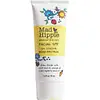What's inside
What's inside
 Key Ingredients
Key Ingredients

 Benefits
Benefits

 Concerns
Concerns

 Ingredients Side-by-side
Ingredients Side-by-side

Caprylic/Capric Triglyceride
MaskingGlycerin
HumectantPolyglyceryl-6 Stearate
EmollientC13-15 Alkane
SolventPentylene Glycol
Skin ConditioningMica
Cosmetic ColorantC15-19 Alkane
SolventSilica
AbrasiveCetearyl Nonanoate
EmollientInulin
Skin ConditioningSqualane
EmollientCarthamus Tinctorius Seed Oil
MaskingSimmondsia Chinensis Seed Oil
EmollientAloe Barbadensis Sprout
HumectantArgania Spinosa Kernel Oil
EmollientSaccharomyces Ferment
Skin ConditioningCera Alba
EmollientAcacia Senegal Gum
MaskingTocopheryl Acetate
AntioxidantPolyglyceryl-6 Behenate
Emulsion StabilisingCetearyl Alcohol
EmollientXanthan Gum
EmulsifyingGlyceryl Laurate
EmollientSodium PCA
HumectantSodium Citrate
BufferingCitric Acid
BufferingPotassium Sorbate
PreservativeFructose
HumectantGlucose
HumectantInositol
HumectantSucrose
HumectantMyricyl Alcohol
Arachidyl Alcohol
EmollientBenzoic Acid
MaskingSodium Benzoate
MaskingHydroxyacetophenone
AntioxidantCaprylic/Capric Triglyceride, Glycerin, Polyglyceryl-6 Stearate, C13-15 Alkane, Pentylene Glycol, Mica, C15-19 Alkane, Silica, Cetearyl Nonanoate, Inulin, Squalane, Carthamus Tinctorius Seed Oil, Simmondsia Chinensis Seed Oil, Aloe Barbadensis Sprout, Argania Spinosa Kernel Oil, Saccharomyces Ferment, Cera Alba, Acacia Senegal Gum, Tocopheryl Acetate, Polyglyceryl-6 Behenate, Cetearyl Alcohol, Xanthan Gum, Glyceryl Laurate, Sodium PCA, Sodium Citrate, Citric Acid, Potassium Sorbate, Fructose, Glucose, Inositol, Sucrose, Myricyl Alcohol, Arachidyl Alcohol, Benzoic Acid, Sodium Benzoate, Hydroxyacetophenone
Zinc Oxide 16%
Cosmetic ColorantAloe Barbadensis Leaf Juice
Skin ConditioningPersea Gratissima Fruit Butter
EmollientWater
Skin ConditioningCaprylic/Capric Triglyceride
MaskingCaprylyl Glycol
EmollientCetyl Alcohol
EmollientCitrus Sinensis Peel Oil Expressed
PerfumingDaucus Carota Sativa Seed Oil
EmollientEthylhexylglycerin
Skin ConditioningGlycerin
HumectantIsostearic Acid
CleansingJasminum Officinale Oil
MaskingPersea Gratissima Oil
Skin ConditioningPhenethyl Alcohol
MaskingPolyglyceryl-3 Beeswax
EmulsifyingPolyglyceryl-6 Distearate
EmulsifyingRubus Idaeus Seed Oil
EmollientSimmondsia Chinensis Seed Oil
EmollientSodium Ascorbyl Phosphate
AntioxidantSodium Hyaluronate
HumectantPPG-5 Tocopheryl Ether
AntioxidantZinc Oxide 16%, Aloe Barbadensis Leaf Juice, Persea Gratissima Fruit Butter, Water, Caprylic/Capric Triglyceride, Caprylyl Glycol, Cetyl Alcohol, Citrus Sinensis Peel Oil Expressed, Daucus Carota Sativa Seed Oil, Ethylhexylglycerin, Glycerin, Isostearic Acid, Jasminum Officinale Oil, Persea Gratissima Oil, Phenethyl Alcohol, Polyglyceryl-3 Beeswax, Polyglyceryl-6 Distearate, Rubus Idaeus Seed Oil, Simmondsia Chinensis Seed Oil, Sodium Ascorbyl Phosphate, Sodium Hyaluronate, PPG-5 Tocopheryl Ether
Ingredients Explained
These ingredients are found in both products.
Ingredients higher up in an ingredient list are typically present in a larger amount.
This ingredient is an emollient, solvent, and texture enhancer. It is considered a skin-softener by helping the skin prevent moisture loss.
It helps thicken a product's formula and makes it easier to spread by dissolving clumping compounds.
Caprylic Triglyceride is made by combining glycerin with coconut oil, forming a clear liquid.
While there is an assumption Caprylic Triglyceride can clog pores due to it being derived from coconut oil, there is no research supporting this.
Learn more about Caprylic/Capric TriglycerideGlycerin is already naturally found in your skin. It helps moisturize and protect your skin.
A study from 2016 found glycerin to be more effective as a humectant than AHAs and hyaluronic acid.
As a humectant, it helps the skin stay hydrated by pulling moisture to your skin. The low molecular weight of glycerin allows it to pull moisture into the deeper layers of your skin.
Hydrated skin improves your skin barrier; Your skin barrier helps protect against irritants and bacteria.
Glycerin has also been found to have antimicrobial and antiviral properties. Due to these properties, glycerin is often used in wound and burn treatments.
In cosmetics, glycerin is usually derived from plants such as soybean or palm. However, it can also be sourced from animals, such as tallow or animal fat.
This ingredient is organic, colorless, odorless, and non-toxic.
Glycerin is the name for this ingredient in American English. British English uses Glycerol/Glycerine.
Learn more about GlycerinThis oil comes from the seeds of the desert shrub called Jojoba. It is more commonly known as jojoba oil, a non-comedogenic oil.
Jojoba oil does not contain fragrance and has many fatty-acids, making it a great soothing ingredient.
It also contains Vitamin E, a great moisturizing ingredient. Vitamin E is also an antioxidant and protects your skin against oxidative damage.
This ingredient humectant properties, meaning it helps draw moisture from the air. This helps keep your skin hydrated.
While jojoba has antibacterial properties, it is only able to kill some strains of bacteria.
Studies also show it helps in wound healing. In fact, Indigenous cultures have used jojoba as a moisturizer and to help treat burns for centuries.
Fun fact: Jojoba oil similar to natural human skin sebum, so it has a great effect on dry skin. It is also promising with helping to regulate sebum production.
Due to its fatty acid content, Jojoba oil may not be fungal acne safe. We recommend speaking with a professional if you have any concerns.
Learn more about Simmondsia Chinensis Seed Oil